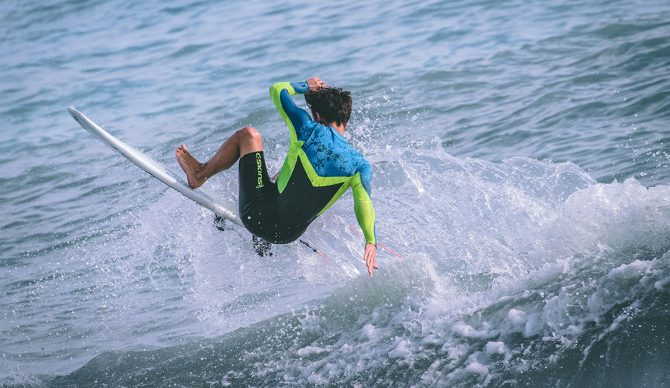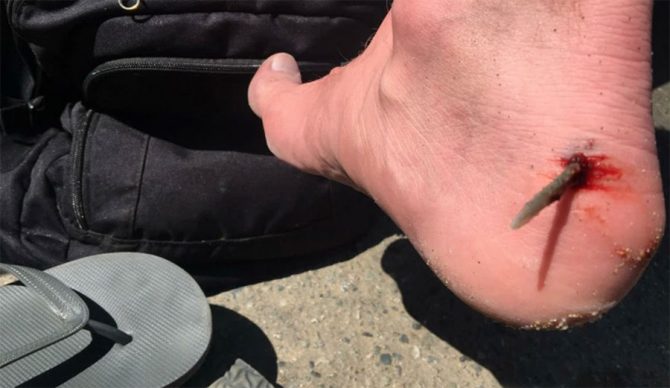
Surfing can leave scars. Photo: Mick de Paola//Unsplash
Go to a local bar and ask a surfer about their injuries from a lifetime in the water. You might swear you’re talking to a war veteran. But there’s some truth to it: surfing leaves scars, and we’ve all got ‘em.
Sometimes you just want a quick fix so that you can stay in the water (like when you’re on a trip, or just frothing). And other times you want to actually heal those nagging injuries.
Here’s a short list of my surf injuries and how they were treated quickly, and then properly.
Yeah, yeah I’m not a doctor and this is not medical advice. We’ve all been on Reddit looking for tricks to keep us in the water — because doc wants us to stay dry. But in the long haul, doc is often right.
Cuts
A brush with the reef or rock can leave deep cuts anywhere and everywhere. The most common area is likely the feet. You might not think twice about a few cuts on your feet, but left untended, you might feel the pain on every pop up.
Some say that saltwater heals, but it also can give you a nasty infection.
I’ve let cuts try to heal raw — and with the friction and nastiness in booties — they just get worse. Eventually, my particular cut got so nasty I could barely stand on my stomp pad without gritting my teeth.
Quick fix: Everyone has their remedy, but I’ve found Bactine to be the best post-surf spray to kill pain and prevent germs. Hydrogen peroxide, rubbing alcohol, or even cheap vodka will do for disinfecting. Before your next session, throw on some bacitracin and cover the wound with a bandaid and some athletic tape. It’s not perfect, but it limits the exposure.
Proper fix: Unfortunately, the best way to let my cuts heal is to stay dry for a while. I keep the wound covered with some bacitracin. Once new skin is formed I’ve found that my body heals quicker when it can breathe at night.
And if I’ve had the kind of cut that demands a trip to the ER…well super glue, staples, and duct tape have worked. But that’s a last resort. Word to the wise, make sure it’s clean before you close it up.
Busted Ribs
There’s a legend that big-wave surfer and Maverick’s pioneer Jeff Clark surfed on broken ribs by wrapping his torso with saran wrap. But we’re not all that metal.
Once I fell onto a shallow reef and busted my ribs. Breathing felt like my heart was cramping. For six months I tried to figure out how to patch the problem.
Quick fix: A mix of hot yoga, daily stretching, and limiting the amount of time in the water would keep the injury in check. I could surf for about 45 minutes, twice a week without issue. But every time I tried to push past that, the injury would exacerbate, and my breathing went all shallow Hal. So I finally went to a doctor.
Proper fix: The primary care doctor took a bunch of X-rays, and said the ribs were fine. I was given some meds and sent off. This fixed nothing. Eventually I went to an acupuncturist who worked with athletes. She did some testing — deep breathing and body manipulation — and concluded that I’d torn an intercostal muscle between the ribs. After 4-5 sessions of acupuncture combined with stim therapy I could surf for longer than before. Within two months I was back to normal, and was only out of the water for one of those months.
Editor’s Note: If you experience shallow breathing, get to a doctor. There’s always a chance you may have punctured a lung.

Stingrays can leave a mark. Photo: Huntington Beach Marine safety Department
Stingray Stings
Between Florida and San Diego alone, I’ve had a dozen stingray stings, some worse than others. Though I’ve never left the water immediately after a sting, it’s probably best to do so if it’s from a larger ray.
Smaller stings have always healed without issue, but one nasty sting from a big ray on the top of the tendon of my foot wouldn’t stop leaking fluid. My foot was a balloon for a month. Probably because I ignored the quick fixes and just let it rip until it started to look infected and gnarly.
Quick fix: After any stingray sting, I would soak that puppy in some hot water. It denatures the venom and relieves a ton of pain. From there I treat it like a cut: clean, disinfect, dab on an antibiotic and cover it up.
Proper fix: If the barb is still in your skin, it might be a good idea to go to a hospital. That was my mistake. A month later a nurse reopened my cut and found shards of the barb still in my foot, which was likely causing more issues in my tissues. Stingray venom can slow tissue healing, so the wound can take longer to heal. A round of antibiotics and a week out of the water got me right.
Unless it’s mission critical, staying out of the water could help the healing process with stingray stings.
Wetsuit Rash
Whether it’s from a wetsuit, sun shirt, or just raw chest on board, the contact rashes you get from surfing can be pretty damn painful in and out of the salt water.
As someone who gets a bi-annual rash from neoprene — but spends life in a wetsuit — these rashes are a bane to my armpits.
Quick fix: All sorts of different quick fixes provided me short-term relief. Applying petroleum jelly before surfing; wearing a rashguard; alternating between calamine lotion and bacitracin. And in a pinch, just surfing shirtless in the California cold. But ultimately rashes don’t like heat and friction.
Proper fix: The best fix has been to stay as dry and clean as long as possible. Which means no ocean, no surfing. Sometimes I even have to stay out of the gym. But this is a great time to take that outdoor hike and show that rash some fresh air.
Find A Balance
Staying in the lineup short term may be better for your immediate mental health, but refusing to heal properly may end up keeping you out for longer than you desire, or even limit your surfing ability. Use these quick fixes to stay wet when you need it. Then take the time to properly heal your wounds so that you can get back to surfing at full health.

